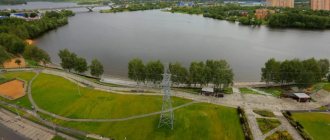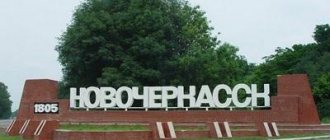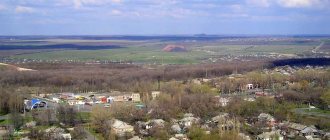The city of Kovrov will quickly help you find a map of Kovrov from a satellite. This city is located on the banks of the Klyazma River. It belongs to the territory of the Vladimir region. The city received its name from the surnames of the Kovrov princes in the 16th century, who owned it. When going on a trip around the city, it is worth using a map of Kovrov with streets in good quality. The map will help you find the object you are interested in very quickly and will save a lot of free time. Kovrov is a small but very beautiful city with magnificent natural scenery.
Where is the city of Kovrov?
Kovrov is the administrative center of the Kovrovsky district of the Vladimir region.
It is a city of regional subordination, within the boundaries of which the Kovrov urban district is formed. It is located on the left and right banks of the Klyazma River, which is a tributary of the Oka River. The approximate population is 137 thousand people, the territory area is 57 square kilometers. The climate in Kovrov is temperate continental with cold winters and warm but short summers. The annual precipitation rate is 569 mm.
Kovrov is located in the same time zone as Moscow, the offset relative to Coordinated Universal Time (UTC) is +3.
Map of Kovrov with streets
There are no districts in this city at all, but the map of Kovrov by district is still useful, since it displays a detailed layout of the city.
Geographically, it is divided into avenues and streets. Throughout the entire territory of the Kovrovsky district there are several rural-type settlements.
Unofficially, the city is divided into microdistricts with corresponding bus and trolleybus routes. For example, district six covers its route with a bus with the same number.
Also, among the people, the territory was divided into 2 microdistricts: northern and southern. The Kovrov map scheme will allow you to move around the city without any problems.
Each microdistrict has its own educational institutions, hospitals and various shopping facilities.
An important railway line passes through the city. Trains going to Siberia or the Urals pass by.
High-speed electric trains also run along this line. Just recently, a new train station was built, which can accommodate more than 900 people at a time. Using Kovrov's routes you can find important roads on the map. This is the exit to the leading road Moscow - Kazan, Kovrov - Ivanovo. Inside the city there are 2 bridges across the Klyazma: railway and for motorists. You can get around the city using buses and trolleybuses.
What is the city of Kovrov known for?
- In the old part of Kovrov there is the Transfiguration Cathedral, which stands on the top of a hill going down to the river. The cathedral was built at the end of the 19th century with the money of parishioners. Since 1934 it has been used as a prison. In 1991, a large-scale reconstruction took place.
- There is a hare museum on Griboyedov Street. More than 1,000 exhibits made of glass, metal, porcelain and other materials are collected here. The museum was founded in 1999.
- On the territory of the city there is a Square named after A.S. Pushkin. Previously, the square was a cemetery. The son of Prince V.A. Kovr is buried here. Today, there is a monument to A.S. Pushkin in the park, and the graves have been put in order thanks to the local administration.
- In 1954, a monument to V. A. Degtyarev was opened in the city. The monument is dedicated to the scientist-designer who was involved in the creation of Soviet weapons. The monument is installed on a pedestal; Degtyarev holds a weapon blank and a caliper in his hands. The authors of the monument are M. G. Manizer, A. P. Velikanov.
- On Griboyedov Street there is a monument to military builders. The monument is made in the form of an obelisk and is dedicated to the work of people who helped the development of the city. The monument was erected in 2016.
- Among the architectural monuments of Kovrov, it is necessary to highlight the Fire Tower, built in 1904. The history of the local fire brigade of 40 people begins in this building. Residents of the city call the tower a “fire castle.”
Kovrov, Vladimir region
Location and travel
Geographic coordinates: Latitude 56°21′49″N (56.363628), Longitude 41°18′40″E (41.31122). Travel from Moscow: By train - 3 hours, High-speed electric train "Lastochka" - 2 hours. 22 min. BlaBlaCar - 4 hours, by bus from the bus station on Shchelkovskaya - 5 hours. Travel from St. Petersburg: By train - 14 hours, BlaBlaCar - 13 hours 10 minutes. Distance from Moscow - 271 km, from St. Petersburg - 976 km.
Sports achivments
In the city of Kovrov, Vladimir region, motorcycle sports are well developed. At the same time, the training of young racers begins at a young age. Many boys dream of learning to drive a two-wheeler. Of great interest is motorball, a rare sport in which football is played on motorcycles. In addition, the city has special markings for motocross racing.
There is a football club in Kovrov. The city's population follows the achievements of local football players. The Kovrovets club was founded back in 1923. During the Soviet era, he took part in many championships among masters and took prizes. In 1995, the club managed to win the championship in the Golden Ring interregional championship. Now “Kovrovets” takes an active part in regional competitions. And some students went up the career ladder and got into federal football teams.
In Kovrov, great attention is paid to children's sports. From the age of 5, children can enroll in a sports dance club. From the age of 7-8 you can start going to athletics, fencing, Greco-Roman wrestling, gymnastics, etc.
Extreme sports are also developing in Kovrov. So, in 2014, a winch for wakeboarding was installed on a local river.
Mass media
Five newspapers are published in Kovrov. The most popular publication can be called “Carpet News”. The newspaper has a circulation of 19 thousand copies. It also has its own portal. Here city residents can find out the latest news, study advertisements for real estate sales, vacancies, etc.
The following periodicals are also published in Kovrov: “Znamya Truda”, “Kovrovskaya Week”, “Echo of the Week”, “Degtyarevets”. There are also 12 radio stations broadcasting in the city. However, Kovrov does not have its own station.
There are 7 analogue TV channels broadcasting in the village. Every city resident has the opportunity to install digital or cable television. In 2014, the city began broadcasting its own channel “Our Region 33”. This is the first channel in the region with its own programming. The advantage is that the broadcast goes on around the clock. Here you can find out all the news from Kovrov. The public can watch programs without connecting to cable television.
“Our Region 33” is a channel that creates interesting programs in various formats. This includes news, programs for children, and entertainment shows. You can hear a lot of good reviews about the program “It’s not evening yet.” Guests include politicians, creative intellectuals, city emergency workers and other interesting residents of Kovrov.
How Rozhdestvino became Kovrov
In the 14th century, the village and surrounding lands were donated to the princes from the Starodubsky family. Their nickname was Carpets, since one of them, during the Battle of Kulikovo, broke into Mamai’s headquarters and took out an expensive carpet. The nickname turned into a surname, and the village began to be called Kovrovo. Prince Vasily built a high tower on Klyazma, and allocated a place for the priests near the lake, named Popov. In 1523, he died near the city of Polotsk, but was buried in Kovrov in the family cemetery. The village went to his son Semyon, and then to his grandson Ivan. In 1567, he donated Kovrovo and nearby lands to the Spaso-Efimov Monastery, which served as an impetus for their development. The prince's tower was also given to the monks as an official hut. It carried out trials and reprisals against local residents. Catherine II liked the Vladimir region. She took away the carpets from the monastery and gave it the status of a city. From then on, its new history began, the most important stage of which was the construction of the railway line.
Industry and economics
Kovrov is a major industrial center. What is the price of the Degtyarev plant! Here they manufacture high-quality small arms and missile weapons, motorcycles, mopeds, sewing machines, etc. Today, the entire industry of Kovrov rests on this company. Construction of the plant began in 1916. Initially it was a rifle and machine gun factory, the main defense institution of the city. Nowadays, special equipment for the food industry is also manufactured here.
The Kovrov Mechanical Plant can also be called the pride of the city. Small arms, glass cutting equipment, solar panels, and equipment for nuclear power plants are also manufactured here.
The Kovrov Electromechanical Plant produces hydraulic drive equipment, as well as defense robotics. The excavator plant produces high-quality agricultural equipment. In 2011, a monument to the excavator was erected in the city. The enterprises described occupy more than 70% of the city's total industry. About 50% of Kovrov’s working-age population is employed here.
The light industry sector is also thriving here. LLC produces consumer goods from plastic. These are garden goods, snow shovels, children's plastic skis, etc. A lot of good reviews can be heard about the Sudar clothing factory, which specializes in the production of men's suits.
Population
How the number of people living in the city changed can be traced through the history of Kovrov. A rapid influx of people here has been observed since the construction of the railway began. In 1856 there were more than 2,000 people here, and within 100 years this figure had grown to impressive proportions. In 1959, the official population was already more than 98 thousand.
The largest population here was observed in the early 90s. At that time, more than 162 thousand people lived here. Then, due to the emergency and economic crisis, Kovrov’s birth rate decreased significantly. The population began to decline. According to the latest data, only 138 thousand people live here. Today the city ranks 128th in terms of population in Russia.
Natural resources
The Vladimir region is located in a wonderful natural region. Kovrov grew up on the banks of the Klyazma, across which there are two bridges in the city. Nearby is the Klyazminsky reserve, which occupies the land between Kovrov and the Teza River. There are many reservoirs in these places - 67 lakes with an area of up to 45 hectares, 19 with an area of up to 1 hectare, as well as smaller ones. Berries and mushrooms are collected in the forest tracts around Kovrov. There are 50 species of large and small mammals (hares, squirrels, foxes, moose) and more than 200 species of birds, including hazel grouse, black grouse, ducks, and wood grouse.
History of the railway in Kovrov
The modern map of Kovrov, Vladimir region, displays all the transport arteries available in the city, reliable and convenient. However, everything was not always so good. Work on the creation of the Moscow-Nizhny Novgorod branch began in 1858. 7 years later, the first train was launched on it, which crashed in the area of the current Kovrov-1 station. For two years they corrected the deficiencies, but it was not possible to launch a new train, because near the Kovrov station a water pump and two spans of the bridge collapsed into Klyazma. To build a new one, the flow of the river had to be changed. To prevent anything else from happening, its supports were painted red. The bridge still bears the name Red. Now the launched train proceeded without incident. Kovrov developed quickly. Railway workshops and many small and large enterprises appeared in the city. During the war, military weapons, bombs and shells for the army were produced here. Now it is the largest industrial center in the region.
Culture
Throughout its history, the city has developed comprehensively. In 2004, the largest International Esperanto Youth Congress was held here, in which children from 23 countries took part. The congress was widely covered in the press. The event was supported by the local administration and private entrepreneurs. Choosing a city to host an Esperanto Youth Congress is a responsible undertaking. And the fact that Kovrov was chosen indicates that the city is truly culturally developed.
There are several cultural institutions in the city. Great importance is attached to the development of the younger generation. There are two art schools, two children's cultural centers, and two cultural palaces. There is also an excellent library system, thanks to which schoolchildren and applicants receive high-quality knowledge. You can hear a lot of good reviews about the family reading library, which anyone can sign up for.
A real landmark of the city is the Kovrov Historical and Memorial Museum. This is not just a place where reminders of the formation of a settlement are collected. It is also a wonderful architectural monument. To get here, you will have to bypass the center of Kovrov and go to the northern part of the city. The museum is located at 20 Abelman Street. The institution was opened in March 1927. The Center for Historical Local History is actively developing. Thanks to the work of the museum, the modern generation can learn the history of the city.
Exhibitions not dedicated to local history are periodically held on the territory of the museum. Thus, you can hear a lot of good reviews about the exhibition “The World of Clay Toys”. Anyone can exhibit their works. The stationary exhibition “The World of Birds and Animals of Our Region” is also popular.
The culture of Kovrov is multifaceted. Six members of the Union of Artists of Russia work and live here. Every year the city hosts the international festival “Commonwealth”.
How did Kovrov come into being?
Even in Neolithic times, the lands on which the Vladimir region is now located were settled. Kovrov, as a city, began its life in 1778 after the decree of Catherine II on the formation of a new district of Kovrovsky. Until then it was a village. Initially, there was a farmstead of a certain Epifanka, a princely trapper, and the place was called Epifanovka. This happened in the 12th century, under Prince Dolgoruky. His son Andrei, nicknamed Bogolyubsky and later canonized, was a passionate hunter. One day, on Christmas Eve, in a severe snowstorm, he was returning from Suzdal to Starodub. Now this is the Klyazma town. Kovrov (Vladimir region), whose attractions are known far beyond the region, is proud of this historical place. Andrey Yuryevich has lost his way. The road led him to the courtyard of Epiphanes. In honor of his salvation, he ordered a wooden church to be built in Epifanovka. The trapper's son took up the matter. For his diligence, he was granted forests, meadows and wastelands, called Epifanovsky, and the village began to bear the name Rozhdestvino. In those days, Tatars often raided Rus'. Residents of unfortified villages fled to forests and large settlements. Rozhdestveno was burned to the ground by the invaders. There are almost no inhabitants left there. Even the Epifanovs moved to Suzdal.






